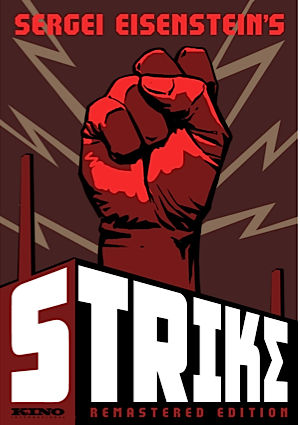
At the 84th Annual Academy Awards the film, The Artist (2011), was awarded the Oscar for Best Motion Picture, as well as Best Director.
Most people have heard this film reviewed as a charming Valentine to Hollywood’s golden age of silent film. Those who have not seen it, however, are likely unaware that the film opens with a shameful and blatant episode of anti-Soviet and anti-Russian propaganda that has no place in advancing the plot of the film and was obviously tacked on to reflect the personal prejudices of someone involved in the film’s production.
The film has also been slammed by American screen legend Kim Novak for sampling a large portion of the score from the 1958 film Vertigo in which Ms. Novak starred. So if you want the unique experience of watching a silent film, I would ignore The Artist and seek out one of the classic works of Sergei Eisenstein instead. They are currently available on DVD.
Russian director Sergei Eisenstein worked creating both silent and sound pictures until his death in 1948. His radical innovations have proved immensely influential even today.
He is perhaps best known for the films Battleship Potemkin (1925), often regarded as his masterpiece, and appearing on nearly every critic’s list of the greatest films of all time, as well as October (1927), which used actual veterans of the storming of the Winter Palace to re-create the events of the Bolshevik revolution.
It is his first feature film, Strike (1925), however, which is set in pre-revolutionary Russia, that I believe deserves a wider audience and a more appreciative review by those delving into areas of cinema with which they are as yet unfamiliar, such as the silent classics.
The film opens with a passage from V.I. Lenin that is as relevant today as it was when he wrote it in 1907. Once the action begins, one is immediately struck by the remarkable camera angles, the use of reflections and silhouettes as well as the dissolves and montage techniques. There are also swooping aerial shots from inside a factory that make for startling images.
The drama of the action remains powerful as well, such as in a scene where a worker, distraught over having been falsely accused of theft, takes his own life. This tragedy in the film results in a work stoppage and eventually a walk out in which the workers cart the factory manager out of the building in a wheel barrel, dumping him down a steep embankment and depositing him in a polluted stream.
Eisenstein’s photographic brilliance isn’t limited to the whirring gears of great machines or masses of toilers streaming from factory gates by the hundreds. His close examination of characters is also compelling. There is the factory owner in his silk top hat, frequently surrounded by cigar smoke and so bloated he can barely wedge himself behind his desk.
Once the factory is abandoned, a delightful scene occurs as the owner wanders about his empty office, helpless to operate even a typewriter.
There are also the profiles of a motley cast of informants with colorful code names as ‘the Monkey,’ ‘the Bulldog,’ and ‘the Fox,’ who disguises himself as a blind beggar in order to better spy on the enemies of capitalist exploitation. In addition, the scene in which an agent of the Tsarist secret police approaches an odious misfit to recruit strike-breakers from amongst the ranks of the lumpen proletariat is not one the viewer will soon forget.
Most striking of all, however, is that while viewing the film you realize that the tactics of the ruling class, regardless of what country they happen to be in, and the challenges faced by the working class, have not changed since this film was produced in 1925. Indeed, much of it will be shockingly familiar to those involved in the current struggles for labor, peace, and justice.
Renewed interest in silent film is certainly positive from the standpoint of increasing one’s own cultural experiences, but novelty will never take the place of quality. Films such as Eisenstein’s Strike set the gold standard in this realm, while pictures such as The Artist may be little more than a curious footnote to future students of film.
Photo: Forward.com









